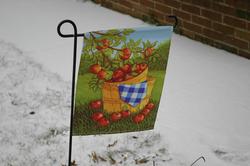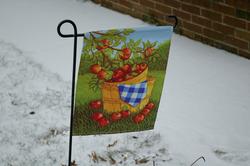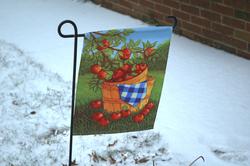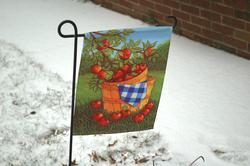| In August,
2003 I put my thumb through the shutter in my Nikon FE2 (don't ask) and
decided I needed a replacement for taking pictures of the kids.
Since I'm a tech guy digital was the way to go and
so I bought a Nikon
Coolpix
4300. Not an equivalent camera, for sure, but very nice for a point-and-shoot you
can take anywhere. Eventually, though, I just got tired of
missing shots, not having a depth of field control, and whatnot and
bought a Nikon
D70 in December 2004. All this time I've used (almost) only
Linux and, in the
spirit of open-source, I thought I'd share some of the hints, scripts,
links, and other assorted foo I've gathered thus far. |
| Anything to add? I'm sure
you can figure out how to email me based on this URL. But I'm not
a support resource :) |
| My
Linux Environment |
| Getting Pictures
from the Coolpix 4300 |
| Getting Pictures from the
Nikon D70 |
| Getting Pictures with
a
Card Reader |
| Nikon Coolpix 4300 Setup |
| Nikon D70 Setup |
| Post-Processing Your
Pictures |
| Extracting
Exif Data |
| Playing
with RAW Files |
| Sample
Pictures |
| Printing
Pictures |
| Useful
Links |
| My
Linux Environment |
| hardware: |
|
generic workstation running Fedora Core 2
IBM Thinkpad A31 running Fedora Core 1 VMware Workstation 4.5.2 running Windows 2000 (why? look here) |
| software that
you will want (at least if you want to run my scripts): |
|
rsync (included with Fedora)
jhead jpegtran (included with Fedora) exifautotran jpegexiforient (just gcc -o jpegexiforient jpegexiforient.c) Image::ExifTool exiftool (included with Image::ExifTool) ImageMagick (included with Fedora) neftags2jpg (requires this version of exiv) cjpeg (included with Fedora) dcraw |
| Getting Pictures
from the Coolpix 4300 |
| Basically,
both cameras support USB Mass Storage, so getting the pictures from the
camera to your computer couldn't be easier. If you're new to
digital photography you might be tempted to use gtkam, gphoto, or some other
tool, but USB Mass Storage is much easier, especially for the Nikons. Fedora Core 1 and Core 2 both recognized the cameras when plugged directly into the computer. How do you know? check dmesg. This is what it spits out after I connect the Coolpix 4300: |
|
$ dmesg ... usb 1-6: new high speed USB device using address 2 Initializing USB Mass Storage driver... scsi1 : SCSI emulation for USB Mass Storage devices Vendor: SanDisk Model: SDCFH-512 Rev: 0 0 Type: Direct-Access ANSI SCSI revision: 02 SCSI device sda: 1000944 512-byte hdwr sectors (512 MB) sda: assuming Write Enabled sda: assuming drive cache: write through sda: sda1 Attached scsi removable disk sda at scsi1, channel 0, id 0, lun 0 USB Mass Storage device found at 2 usbcore: registered new driver usb-storage USB Mass Storage support registered. usb 1-6: USB disconnect, address 2 |
| Along with that, it created a
new mount point, /mnt/camera,
so |
| and I'm golden - the pictures
are in dcim/100nikon/
just waiting to be moved to your workstation. how do you do
that? well, I wrote a script for it: |
|
#!/bin/ksh # first, mount the camera mount /mnt/camera # now copy the pictures from the camera to /pictures rsync -rtuv --exclude info.txt /mnt/camera/dcim/100nikon/ /pictures/ # umount the camera now, just to be safe - we don't # want to manipulate pictures on the CF card until # we know they were transfered properly umount /mnt/camera # protect your pictures! make sure you can't delete them by accident cd /pictures/ chmod 0444 *.jpg # now, shuffle the pictures around a bit for i in *.jpg do # extract the date/time from the exif data and # make it match the timestamp on the file itself time=`exiftool -d '%c' -DateTimeOriginal $new | sed 's/.* ://'` touch -d "$time" $i # create /pictures/YYYY-MM to store the pictures in, if required dir=`date -d "$time" +"%Y-%m"` if [ ! -d $dir ]; then mkdir $dir fi # move the pictures to /pictures/YYYY-MM if [ -e $dir/$i ]; then echo "removing $i - $dir/$i exists?" rm -f $i else mv --reply=no $i $dir fi done cd - |
| now, you might be asking why I
bother to extract out the exif data and transfer the time the picture
was taken to the file on disk. well, because I have two cameras
the picture names overlap and sort order gets all messed up. by
doing this I can sort via mtime
and my pictures list in their proper chronological order, not the order
in which I chose to transfer them to my computer. |
| Getting
Pictures from the D70 |
| This is
pretty much the same as with the 4300. The
only difference is the name of the directory the D70 puts the pictures
in on the CF card, and the fact that the D70 knows the orientation of
the pictures so
we can rotate them on the fly. I should note that this script assumes you're shooting in JPG mode and not RAW mode. I'm really nowhere near a professional, so a 3MB jpeg is just fine for me. YMMV. |
|
#!/bin/ksh
# first, mount the camera mount /mnt/camera # now copy the pictures from the camera to /pictures rsync -rtuv /mnt/camera/dcim/100ncd70/ /pictures/ # umount the camera now, just to be safe - we don't # want to manipulate pictures on the CF card until # we know they were transfered properly umount /mnt/camera # the D70 messes with the picture names - depending # on the RGB setting it could be called _dsc0001.jpg # or dsc_0001.jpg. I find this annoying, so I normalize # the names cd /pictures/ for i in *.jpg; do new=`echo $i | sed -e 's/_//'`; mv --reply=no $i $new; done # rotate the pictures based on exif orientation data exifautotran *.jpg # protect your pictures! make sure you can't delete them by accident chmod 0444 *.jpg # now, shuffle the pictures around a bit for i in *.jpg do # extract the date/time from the exif data and # make it match the timestamp on the file itself time=`exiftool -d '%c' -DateTimeOriginal $new | sed 's/.* ://'` touch -d "$time" $i # create /pictures/YYYY-MM to store the pictures in, if required dir=`date -d "$time" +"%Y-%m"` if [ ! -d $dir ]; then mkdir $dir fi # move the pictures to /pictures/YYYY-MM if [ -e $dir/$i ]; then echo "removing $i - $dir/$i exists?" rm -f $i else mv --reply=no $i $dir fi done cd - |
| actually, these are only close
approximations of the scripts I use - since I have both cameras and fiddle with raw
(compressed NEF) data files from time to time I
combined them. the real
script I use is this (yeah, it's ugly, but my shell skills are
weakening thanks to
Perl ;) |
|
#!/bin/ksh cd /pictures/ mount /mnt/camera if [ $? -ne 0 ]; then echo "no camera to mount?" exit 1 fi if [ -d /mnt/camera/dcim/100ncd70/ ]; then rsync -rtuv /mnt/camera/dcim/100ncd70/ /pictures/ umount /mnt/camera exifautotran *.jpg else rsync -rtuv --exclude info.txt /mnt/camera/dcim/100nikon/ /pictures/ umount /mnt/camera fi for i in *.jpg do if [ ! -e $i ]; then echo "*** no jpg files to process" continue fi new=`echo $i | sed -e 's/_//'` mv --reply=no $i $new chmod 0444 $new time=`exiftool -d '%c' -DateTimeOriginal $new | sed 's/.* ://'` touch -d "$time" $new dir=`date -d "$time" +"%Y-%m"` if [ ! -d $dir ]; then mkdir $dir fi if [ -e $dir/$new ]; then echo "removing $new - $dir/$new exists?" rm -f $new else mv --reply=no $new $dir fi done for i in *.nef do if [ ! -e $i ]; then echo "*** no nef files to process" continue fi new=`echo $i | sed -e 's/_//'` mv --reply=no $i $new chmod 0444 $new time=`exiftool -d '%c' -DateTimeOriginal $new | sed 's/.* ://'` touch -d "$time" $new dir=`date -d "$time" +"%Y-%m"` if [ ! -d raw/$dir ]; then mkdir raw/$dir fi if [ -e raw/$dir/$new ]; then echo "removing $new - raw/$dir/$new exists?" rm -f $new else jpg=`echo $new | sed -e s/\.nef/-raw\.jpg/` echo "writing nef $dir/$jpg" dcraw -c -w $new | cjpeg -Q 95 > $dir/$jpg neftags2jpg $new $dir/$jpg chmod 0444 $dir/$jpg touch -d "$time" $dir/$jpg mv --reply=no $new raw/$dir fi done cd - |
| Getting Pictures from a
Card Reader |
| Plugging in
the camera all the time is a drag, especially when you consider how
quickly the 4300 drains its battery. So, I use a card
reader now instead. Unfortunately, Fedora didn't give me mount
points for either of my cards automatically (a SanDisk 128MB for the
4300 and SanDisk 512MB Ultra II for the D70) so I had to create entries
for them myself in /etc/updfstab.conf.default.
I chose to add the entry under the camera device so that my
scripts would work no matter how I connect to the CF card. |
|
device camera { partition 1 match hd DSC match hd CAMERA match hd USB-DRIVEUNIT match hd PENTAX match hd PSC match hd SanDisk } |
| with the "match hd SanDisk"
entry added I was free to mount /mnt/camera and
extract the pictures using the same script I use
to move pictures
directly from the cameras. The SanDisk part matches the output
from dmesg above, so if you're not using a SanDisk card, check
your own dmesg ouput and
adjust accordingly. |
| Coolpix 4300 Setup |
| There really
isn't much to do with the 4300. The only tweaks I have made is to
set the scene mode to portrait, center weighted, and the manual mode to
multiple exposure mode. that way I can quickly switch between
getting a close-up of my kids or snapping of a few shots in a row,
hoping to get a smile. |
| Nikon D70 Setup |
| Ok, this is
why I really am writing this page. Setting up the D70 isn't all
that difficult, but there are a bunch of things you can do to make life
easier. These are just a few I've found helpful. |
| You can't
really take good pictures right out of the box - they will be dark,
unbalanced and an overall disappointment. I think Nikon does this
because it expects users of a higher-end camera like this will
post-process all of their pictures using photoshop or something.
yeah, like I have the time for that. If you are like me and want relatively good looking pictures all the time, you will want to place a color curve directly on the camera and adjust a few other settings. Rather than repeat what others have done, I'll just point you to the right places: |
| note that
for the second step (installation of the custom color
curve) you will need Nikon
Capture, which only runs on windows and which isn't included with
the camera. Nikon offers you a 30 day trial period, which is
sufficient for uploading a curve to your camera. Remember that
you can always turn off the custom curve, so there really isn't any
harm in loading it up just in case. Oh, and since you're a geek you'll probably see the firmware link and run off to upgrade your firmware but there probably isn't a need - if you just purchased the camera and are reading this then the camera you have probably has the latest firmware already, so check your versions before you waste your time. |
| I should say
that when I first got the camera I took about 100 shots of the same
thing (an outdoor still) using various settings - with the curve,
without the curve, with and without the tone and sharpness settings
suggested in
the first step, and everything inbetween. I
found that the pictures I took with the suggested settings really did
look the best, but YMMV. |
| After you get the color settings
for the camera situated, you might want to tweak the interface as
well. These
are some settings that may help you get started - I like like almost
all of his suggestions, but you can make up your own mind. In
addition to those, I've made some additional tweaks not mentioned there: |
|
1. Turn the CSM Menu option to Detailed (page 161 in the D70
manual). This lets you see all the menu options available to you,
not just a subset.
|
|
2. Set the File Number Sequence setting to
On (page 159).
If you don't do this then the picture numbering will start at 0001 every time you use a
different card, reformat the current card, etc. how annoying.
|
|
3. Set Rotate Tall to Off (page 126). This
allows you to actually see the picture in the review screen after you
take a portrait-oriented picture. It doesn't affect the image on
the CF card in any way.
|
|
4. I prefer to shoot in Aperature Priority mode, but
don't like that the aperature control is the dial on the front of the camera. You can
toggle which dial controls the aperature using the Command Dial menu option (page
147).
|
| Post-Processing
Your Pictures |
| I'm still
learning about post-processing, so I don't have much to share with you
here. But I will point you to GimpGuru,
a great site with lots of very useful tutorials for using the
Gimp (a free photoshop-equivalent program). |
| to just make
thumnails or something I use convert,
one of the command line tools that comes with ImageMagick. |
|
$ convert -size 71 foo.jpg -resize 71 /pictures/thumb/foo.jpg |
| Extracting
Exif Data |
| Image::ExifTool is a great
Perl package for extracting out Exif
data, including all of the Nikon-specific tags that other tools (like
jhead) don't know about. this is a quick script I use to
look at
the data from an image: |
|
use Image::ExifTool; my $info = Image::ExifTool->new->ImageInfo($ARGV[0]); foreach my $key (sort keys %$info) { (my $value = $info->{$key}) =~ s/\s+/ /g; print "$key => $value\n"; } |
| but viewers like gThumb have
most of this, so
you may not need it. however, one thing I like to do is extract
exif data out to a file and diff
it against other images to see which setting in a series worked best,
and this
script helps. in fact, I wrote exifdiff, which will accept a
list of files and then tabulate and show only (important)
differences. like this: |
|
$ exifdiff dsc0448.jpg dsc0449.jpg dsc0450.jpg tag dsc0448.jpg dsc0449.jpg dsc0450.jpg -------------------------------------------------------------------------------------------------- ExposureCompensation -1/3 -2/3 0 ShutterSpeed 1/200 1/250 1/250 |
| the code behind exifdiff is so ugly that I just
can't share it at the moment. after I clean it up I'll post it,
though. |
| Playing
with RAW Files |
| I have
started playing around with raw files, which in the case of the D70 are
compressed NEF format. dcraw
and cjpeg are the keys
here, allowing me to script conversions from raw to jpeg without
needing to use Nikon Capture. besides the conversion to jpeg you
need to copy the exif data from the raw file as well, which is what neftags2jpg
does. as
you can see from the above script, this is the
way I have been converting .nef files to .jpg: |
|
$ dcraw -c -w dsc0001.nef | cjpeg -Q
95
> dsc0001.jpg
$ neftags2jpg dsc0001.nef dsc0001.jpg |
| I found that the -w flag on dcraw produces a color that I
like much better than the resuls from dcraw's default, the in-camera
jpg, or Nikon Capture, but that dcraw
tends to blow out the highlights a bit. worst case, I figure I
can always use Nikon Capture to recreate the jpg that the camera would
have produced, so I'm no worse off for using dcraw. |
| here is a sample image in a few
different formats. for this tests I shot in RAW+BASIC mode so you
wouldn't be distracted by subtle differences in picture
composition. the original NEF file is 5.0M. |
camera
generated jpg (BASIC,
originally 709K) too dull and grey |
nikon capture generated jpg
using my in-camera settings and no exposure compensation (originally
1.1MB) a bit better, but not by much |
dcraw without -w (originally 1.5M) way too blue |
dcraw with -w (originally 1.5M) the best of the lot, I think. I probably could have done better with nikon capture if I had played with things a bit. but this is just as good as having RAW+FINE (which we don't), and gives me a better idea of what I could get with nikon capture or a gimp plugin like UFRaw. |
| Sample
Pictures |
| As I said, I
am by no means a professional photographer, but I'm trying my best to
create some good pictures of the family we'll all look back on a smile
about. That said, here are some pictures you can look at if you
want to see the color saturations, etc of the different cameras.
They aren't meant to be works of artistic genius or anything - I simply
thought they had nice contrast to them, and were representative of how
each camera tends to look to me. Please keep in mind that these are ~100k in size (to save bandwidth), whereas the original picture is around 1.2MB (for the 4300) or 3MB (for the D70) - sharpness and other attributes are lost in the compression and the real pictures look much better. |
|
4300 pictures
(in FINE mode, no post-processing)
|
| Printing
Pictures |
| A friend of
mine who has been at digital photography longer than I have said he
tried absolutely every digital processing place there is (for US
customers, at least) and couldn't find one with better pictures than Ofoto. I've
used only Ofoto
exclusively and think the pictures look great. The only problem
with Ofoto is that they don't have an API so I can script uploads,
which is a drag. But maybe someone will reverse engineer one
someday... |
| Useful Links |
|
Another
D70 on Linux page - lots of stuff on RAW manipulations
|
|
Tons of
photoshop
tutorials that may or may not apply to the Gimp
the digital
greycard article is definitely worth a read
|
|
Another
D70 review
that includes techincal details you will want to know about
|
|
UFRaw a RAW converter
for Gimp that seems to do the job well
|